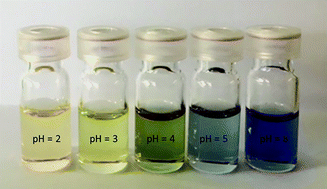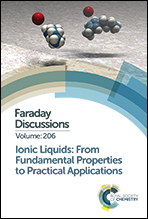Brønsted acidity in deep eutectic solvents and ionic liquids
Abstract
Despite the importance of ionic liquids in a variety of fields, little is understood about the behaviour of protons in these media. The main difficulty arises due to the unknown activity of protons in non-aqueous solvents. This study presents acid dissociation constants for nine organic acids in deep eutectic solvents (DESs) using standard pH indicator solutes. The pKIn value for bromophenol blue was found by titrating the DES with triflic acid. The experimental method was developed to understand the acid–base properties of deep eutectic solvents, and through this study it was found that the organic acids studied were slightly less dissociated in the DES than in water with pKa values between 0.2 and 0.5 higher. pKIn values were also determined for two ionic liquids, [Bmim][BF4] and [Emim][acetate]. The anion of the ionic liquid changes the pH of the solution by acting as a buffer. [Emim][acetate] was found to be more basic than water. It is also shown that water significantly affects the pH of ionic liquids. This is thought to arise because aqueous mixtures with ionic liquids form heterogeneous solutions and the proton partitions into the aqueous phase. This study also attempted to develop an electrochemical pH sensor. It was shown that a linear response of cell potential vs. ln aH+ could be obtained but the slope for the correlation was less than that obtained in aqueous solutions. Finally it was shown that the liquid junction potential between two reference electrodes immersed in different DESs was dependent upon the pH difference between the liquids.

- This article is part of the themed collection: Ionic liquids: from fundamental properties to practical applications


 Please wait while we load your content...
Please wait while we load your content...